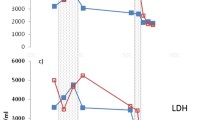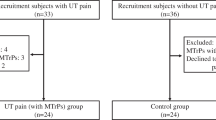Abstract.
In the literature enlarged/increased cross-sectional area (CSA) of type I muscle fibres has been reported as a morphological mark of work-related localised myalgia in the descending part of the trapezius muscle of women. These studies did not use enough subjects or lacked an adequate control group. The recording of surface electromyograms (EMG) is central to the research field of work-related myalgia. However, the influence of intrinsic muscle properties – such as the effect of muscle fibre distribution upon surface EMG – has to be better understood in order properly to evaluate this method as a possible diagnostic and preventive tool. This study had two aims. Firstly, it investigated the muscle fibre distribution and CSA in work-related myalgia in trapezius muscles. Secondly, the multivariate relationships among muscle morphology and histochemistry [ragged-red (RR) fibres, and cytochrome-c-oxidase-negative-fibre changes] EMG, perceived fatigue, and biomechanical output of shoulder flexions were analysed. The raw data have been presented in an earlier study. The participants in this study were 25 female cleaners with work-related myalgia of the trapezius muscle and 25 female cleaners not experiencing work-related myalgia of this muscle. The control group comprised 21 healthy female teachers who had not been exposed to highly repetitive work or static muscle work. Smaller CSA of type II fibres were found in cleaners compared to teachers. In this study the CSA of type I fibres of the trapezius muscles associated with myalgia were no greater than in muscles without myalgia. The prevalence of RR fibres together with age, fibre type proportions, CSA and working as a cleaner correlated with the ability to relax as recorded electromyographically. The relative mean frequency of the EMG of the trapezius muscle correlated with the prevalence of RR fibres, but it did not correlate with the proportions and CSA of different fibre types. Low biomechanical outputs and low signal amplitude increases of the EMG during the test were associated with high proportions of type IIB fibres. The smaller CSA of type II fibres in cleaners might have reflected a different muscle activation pattern due to different occupational demands in cleaners than in teachers. Morphological or histopathological variables can influence the three EMG variables investigated.
Similar content being viewed by others
Author information
Authors and Affiliations
Additional information
Electronic Publication
Rights and permissions
About this article
Cite this article
Larsson, .B., Björk, .J., Elert, .J. et al. Fibre type proportion and fibre size in trapezius muscle biopsies from cleaners with and without myalgia and its correlation with ragged red fibres, cytochrome-c-oxidase-negative fibres, biomechanical output, perception of fatigue, and surface electromyography during repetitive forward flexions. Eur J Appl Physiol 84, 492–502 (2001). https://doi.org/10.1007/s004210100409
Accepted:
Issue Date:
DOI: https://doi.org/10.1007/s004210100409




